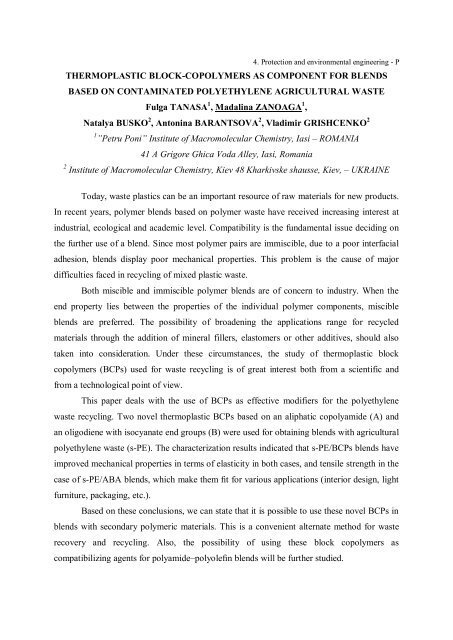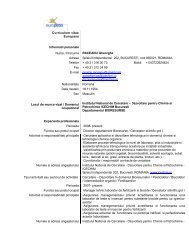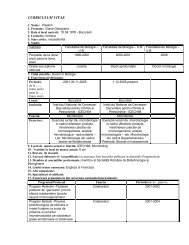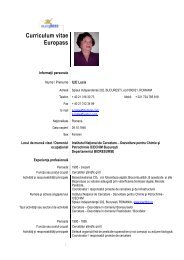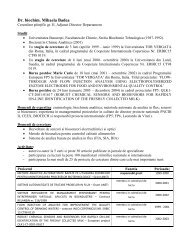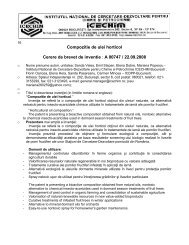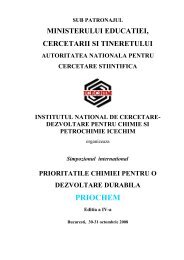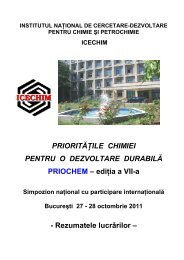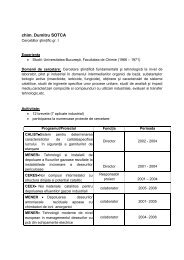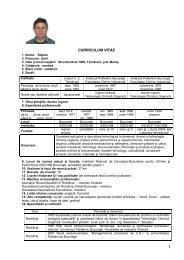INSTITUTUL NAÅ¢IONAL DE CERCETARE-DEZVOLTARE - ICECHIM
INSTITUTUL NAÅ¢IONAL DE CERCETARE-DEZVOLTARE - ICECHIM
INSTITUTUL NAÅ¢IONAL DE CERCETARE-DEZVOLTARE - ICECHIM
- No tags were found...
You also want an ePaper? Increase the reach of your titles
YUMPU automatically turns print PDFs into web optimized ePapers that Google loves.
4. Protection and environmental engineering - PTHERMOPLASTIC BLOCK-COPOLYMERS AS COMPONENT FOR BLENDSBASED ON CONTAMINATED POLYETHYLENE AGRICULTURAL WASTEFulga TANASA 1 , Madalina ZANOAGA 1 ,Natalya BUSKO 2 , Antonina BARANTSOVA 2 , Vladimir GRISHCENKO 21 ”Petru Poni” Institute of Macromolecular Chemistry, Iasi – ROMANIA41 A Grigore Ghica Voda Alley, Iasi, Romania2 Institute of Macromolecular Chemistry, Kiev 48 Kharkivske shausse, Kiev, – UKRAINEToday, waste plastics can be an important resource of raw materials for new products.In recent years, polymer blends based on polymer waste have received increasing interest atindustrial, ecological and academic level. Compatibility is the fundamental issue deciding onthe further use of a blend. Since most polymer pairs are immiscible, due to a poor interfacialadhesion, blends display poor mechanical properties. This problem is the cause of majordifficulties faced in recycling of mixed plastic waste.Both miscible and immiscible polymer blends are of concern to industry. When theend property lies between the properties of the individual polymer components, miscibleblends are preferred. The possibility of broadening the applications range for recycledmaterials through the addition of mineral fillers, elastomers or other additives, should alsotaken into consideration. Under these circumstances, the study of thermoplastic blockcopolymers (BCPs) used for waste recycling is of great interest both from a scientific andfrom a technological point of view.This paper deals with the use of BCPs as effective modifiers for the polyethylenewaste recycling. Two novel thermoplastic BCPs based on an aliphatic copolyamide (A) andan oligodiene with isocyanate end groups (B) were used for obtaining blends with agriculturalpolyethylene waste (s-PE). The characterization results indicated that s-PE/BCPs blends haveimproved mechanical properties in terms of elasticity in both cases, and tensile strength in thecase of s-PE/ABA blends, which make them t for various applications (interior design, lightfurniture, packaging, etc.).Based on these conclusions, we can state that it is possible to use these novel BCPs inblends with secondary polymeric materials. This is a convenient alternate method for wasterecovery and recycling. Also, the possibility of using these block copolymers ascompatibilizing agents for polyamide–polyolen blends will be further studied.


